An Inside Look at RBMA New York 2013
Most people experience the Red Bull Music Academy as a month-long series of sponsored events, […]
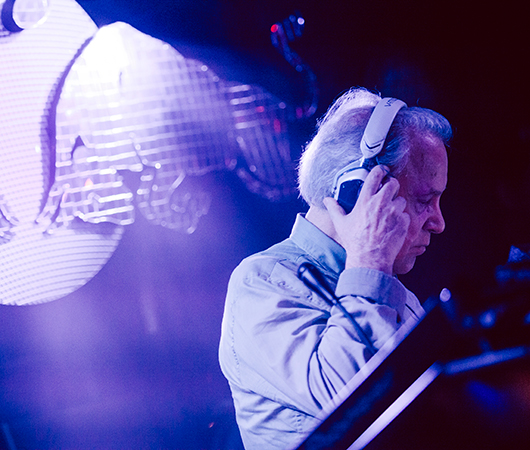
An Inside Look at RBMA New York 2013
Most people experience the Red Bull Music Academy as a month-long series of sponsored events, […]

Most people experience the Red Bull Music Academy as a month-long series of sponsored events, bold advertisements plastered onto tall buildings and subway walls, and copies of the Daily Note newspaper. But those are only the most visible aspects of the Academy’s 2013 edition, which kicked off its second term in New York City this week. In fact, most of RBMA takes place in a single building in Chelsea, where a carefully selected group of 30 musicians from around the world have been set loose in artistically designed, state-of-the-art studios and a contingent of writers, PR agents, and assorted music industry folks labor over various other projects upstairs. When the Academy is in session, RBMA headquarters houses an entire music-business ecosystem that produces not only fresh tunes and an extensive lineup of events, but daily newspapers, art installations, and lengthy lectures from seasoned artists. Since most of RBMA isn’t open to the public, it largely remains a mystery to those not directly involved. As such, XLR8R spent two days scurrying around the epicenter of the behemoth culture machine that is RBMA, taking an inside look at the daily life of its participants.
RBMA Bedroom Studio
Photo: Dan Wilton
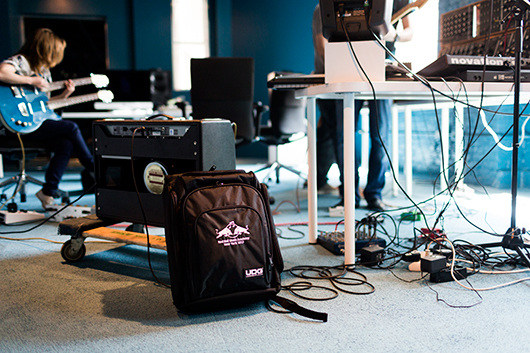
It’s kind of like summer camp for musicians.
On the first day of the Academy, each participant was equipped with a colossal backpack stamped with the RBMA logo, which totally makes them look like students at a DJ sleepaway camp—especially when they’re all waiting in line to get a plate of food in the cafeteria. Every morning, Let’s Play House label owner Nik Mercer rouses the 30 artists from their rooms at the Ace Hotel and shepherds them onto a shuttle bus that transports them to RBMA headquarters. The group generally cruises in around 11 a.m. for breakfast, which usually includes lumpy eggs, stiff hashbrowns, muffins, and—for vegans/vegetarians/tofu-lovers—a tofu scramble. They group together at tables and chat before scattering to their respective studios upstairs to jam or work on beats, after which they file into the main floor auditorium for afternoon lectures. The lectures are the only events that the participants are required to attend; after dinner, they can choose whether or not they’d like to climb back onto the bus and attend the various nightly events.
It was a tight schedule for the group—too tight to explore the city. “I’ve just been to and from [the headquarters and events] every day. I haven’t seen anything else,” RBMA participant and Rinse FM DJ T. Williams told us Tuesday afternoon. Likewise, Austrian songwriter Squalloscope (a.k.a. Anna Kohlweis) and Italian musician Mr. Selfish (a.k.a. Alberto Spezzaferro) said their time in New York has been completely absorbed by RBMA, which, they agreed, was “like the best camp ever.” The cafeteria food, friendly getting-to-know-you conversations, enlightening lectures, and shuttle buses reminded them of school trips—except a lot more fun, and with cooler people who share similar interests.
Torsten Schmidt of RBMA, Trancemicsoul, and Todd Burns of RBMA
Photo: Dan Wilton
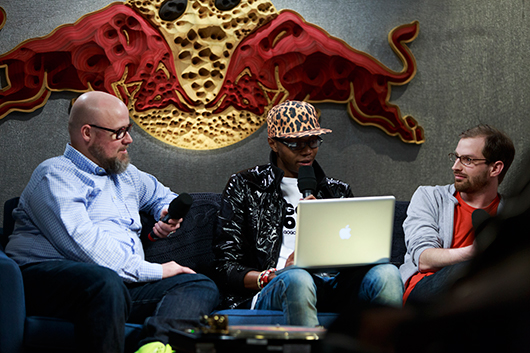
The students are excited to collaborate on new tunes.
On Monday afternoon, each producer sat down with RBMA lecture hosts Todd Burns and Torsten Schmidt to introduce themselves and play a bit of their music for the rest of the crew. Each one was asked a few basic questions about their lives and then grilled on what they hoped to take away from their time at the Academy. The standard answer was, “I’m excited to collaborate with other musicians,” and they all genuinely seemed to be.
A few of the artists have already linked up on creative endeavors. After introductions, T. Williams had his eye on two promising musicians: South African house producer Trancemicsoul (pronounced “transmic soul”) and New Zealand-bred singer/songwriter Louis Baker, who both made promising impressions on the group when they presented. Although Trancemicsoul is virtually unknown to the world outside of the South African house scene, the brief clip of the tune he shared bore the influence of European and US deep house sounds. Baker also managed to pleasantly surprise the auditorium. When he took a seat between Schmidt and Burns, one host remarked that he looked stronger than in his press photos, which hadn’t done justice to his stocky, rugby player’s frame. It came as a bit of a surprise, then, when he played one of his tracks, and revealed a soft, sultry, and heartfelt croon.
Torsten Schmidt and Evian Christ
Photo: Dan Wilton
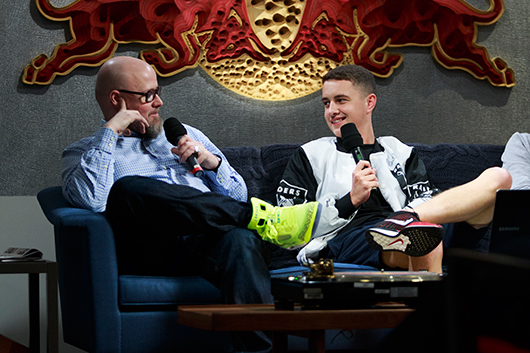
Something is up with Evian Christ.
When UK beatmaker Evian Christ stepped up to the front during the introductions, Schmidt started to hint that he heard through his insider network that some of the producer’s ethereal tracks “are being used.” But Christ swept the comment aside. “Let’s not talk about that yet,” he told Schmidt, shaking his head. “How did you hear about that?”
Giorgio Moroder at Output
Photo: Christelle de Castro
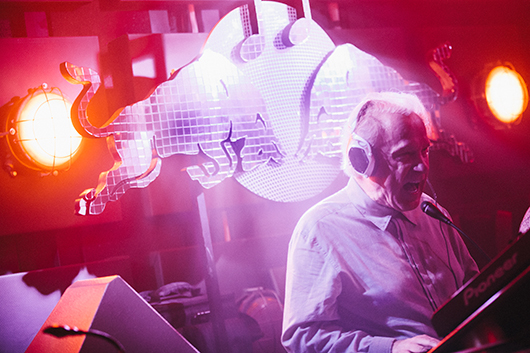
Giorgio Moroder is making EDM bangers, too.
Monday’s lecture featured legendary Italian record producer and label owner Giorgio Moroder, who came ready to share a detailed history of his lengthy career in electronic music. He started by telling Schmidt that his “mommy” was the last person to call him by his birth name, Hansjörg, and went on to explain the recording process behind some of his biggest hits and the tumultuous relationships between the eclectic artists on the roster at Casablanca Records. “There were three main acts. One was Donna [Summer], one was Kiss, and one was the Village People,” Moroder explained. “Each one was pissed at the other.” When Schmidt pulled up a photo of the stalwart producer from the 1970s, Moroder swelled with pride. “Nobody had a mustache like me,” he boasted.
A few short hours after the lecture, RBMA participant Benjamin Damage was behind the booth at Output in Brooklyn, warming up the club for T. Williams, François K, and Moroder himself. “Because it was Giorgio Moroder, I didn’t play really deep techno,” he explained from the studios the next day. “I played most of my synthy [tracks] to ease into it. But I always play stuff that I like and that’s me.” For his part, Williams scaled back on his love for 2-step, although he did let a Bassment Jaxx tune fly toward the end of the set. “I was very aware of how much 2-step and that broken-beat stuff I can play,” he said. “A lot of the stuff that is cool in the UK and especially in London, it doesn’t translate the same [in other countries].”
Benjamin Damage at Output
Photo: Christelle de Castro
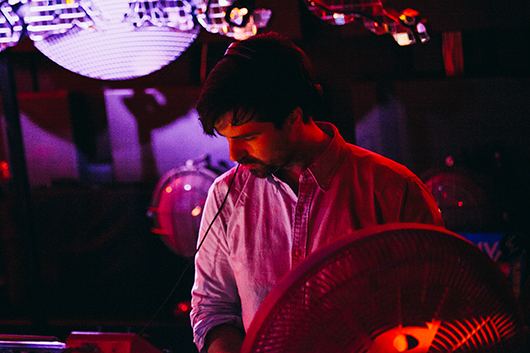
Moroder, on the other hand, dove deep into the sounds that have defined his career. He greeted the audience members, who were standing on tip-toes and hanging from the balconies to get a look at him when he appeared, with a vocoder mic. “My name is Giorgio Moroder,” he said to wild applause. “And this is my musical director,” he said, gesturing to his assistant. Although Moroder seemed to be doing most of the DJing himself, his director stayed by his side to guide him and provide the occasional suggestion during the set, which included classics like “Love to Love You” and “Hot Stuff,” as well as new material from the producer. The unreleased track was a massive European electro banger, complete with sky-high synths and Moroder’s own vocoder singing over the top.
If François K was an aspiring producer/DJ today, he would just give up already.
François K’s Tuesday lecture was full of inspiring and/or sage kernels of information, although it ended on an oddly discouraging note. For two hours, he described how he made a successful career in a “hardcore, intense, relentless” city like New York. He advised the participants not to sign contracts that limited them to a certain record label, and to define clear boundaries between their creative process and the business folks monetizing and enabling its existence. “It’s always control of your own destiny that’s important,” he said. “Don’t expect business folks to have the creative vision that’s inside of you. Stick to what you believe—follow that which is in you and tells you what’s really great. That’s what you should be doing. The payoff is worth the determination to see it through.”
François K on the RBMA lecture couch
Photo: Christelle de Castro
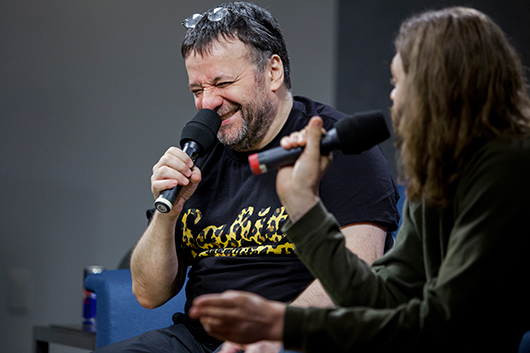
But right at the end of the lecture, François K revealed his inner despair. He started DJing because there was less competition in the field at the time, but the crowded landscape of aspiring DJs and producers that exists today would discourage him from even trying. “For DJing, it’s hard to make something that different and that much better than everything else because the market is inundated with free music. It’s harder to impose yourself on the market,” he explained. “Anyone who’s thinking about [becoming a DJ] should think about going into developing software for music making.”
Benji B and Just Blaze love “Go Bang.”
BBC Radio 1 host Benji B and Just Blaze spent the first few days of term two floating around the RBMA headquarters, attending lectures, meeting with RBMA employees, and eating the free cafeteria cuisine. (On Monday night, Just Blaze was sitting alone at a cafeteria table, eating his pasta, until RBMA participants started to group around and ask him questions.) At the end of François K’s lecture, Benji B took the mic to request that the DJ play a bit of his remix of Dinosaur L’s “Go Bang.” When the mic came around to Just Blaze, the hip-hop producer admitted that he, too, wanted to hear “Go Bang,” but his question “got jacked” before he could ask it. When the track started to play over the auditorium’s sound system, Just Blaze wiggled his fingers as if noodling away on the strings of a guitar.
De La Montagne at Tammany Hall
Photo: Dan Wilton
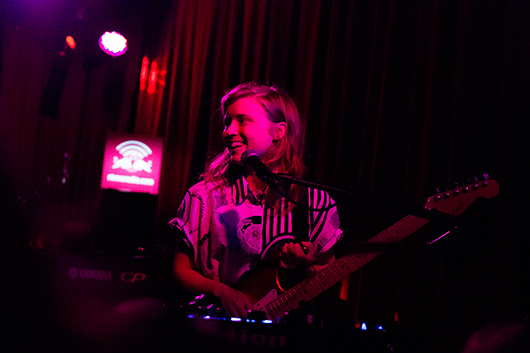
Staying late at the RBMA showcases pays off.
Even after a long day in the studio and lecture hall, the participants aren’t really given the chance to mellow out. Instead, most of them pile onto the shuttle bus and make their way down to the nightly showcase. The breakneck schedule is exhausting, but it’s worth it to power through the pain and hang around the showcases til the wee hours of the morning. On Tuesday night, this meant that the hardcore few who stuck around the Technicolor Coding party at Tammany Hall until 3 a.m. had been out at RBMA events for 16 or 17 hours straight—and they were rewarded handsomely for their stamina. 10 minutes after XLR8R advice columnist Nick Hook took over the booth around 3 a.m., he was joined by TNGHT co-producer Hudson Mohawke and rapper Zebra Katz. Hudson Mohawke needed no introduction, but to herald his arrival, the UK producer opened his guest set with his own “Goooo” track, which was a sufficient hello.
The participants might become a tight-knit group.
Since the artists travel together, work together, eat together, and party together, it’s only natural that they’d get friendly with each other. A handful of the students performed at Tuesday night’s Technicolor Coding showcase, and most of the crew showed up to support their fellow participants. If something went awry onstage, the others jumped in to help; when a cord came unplugged right before French synth-pop producer De La Montagne was plunging into another song, Mr. Selfish jumped to the rescue to sort it out even before the sound crew. “He’s not selfish at all,” she crowed in a strong accent as Mr. Selfish ducked back into the crowd. And during each performance, Austin-based producer Anna Love snuck up to the stage to deposit a rose at her cohorts’ feet.
RBMA participant Kid Smpl in a Bedroom Studio
Photo: Dan Wilton
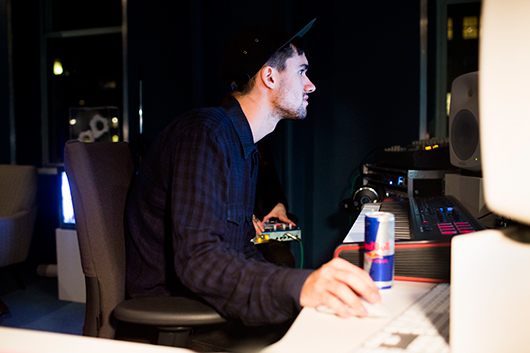
The RBMA HQ is almost too good to be true.
Red Bull’s creative utopia seems like a dream come true for any of the music industry types involved, whether they’re participants or PR agents or journalists. The four floors commandeered by RBMA are constantly humming with energy and camaraderie—it sounds cheesy, but it’s true. Employees are eager to introduce themselves in the elevators and get to know the others in the building, and everyone always seems hard at work scheduling lectures, organizing showcases, putting together the Daily Note, manning RBMA’s very active social media presence, doing interviews, or working on whatever other projects help keep the machine running.
The 7th floor in particular is a hub of artistic fervor. It’s a veritable maze of studios, each of them boxed in by glass walls that allow passers-by to glimpse a group of artists as they work on new tunes. Each studio is equipped with a variety of hardware for the students to jam with, and were individually designed and decorated by different artists. On Tuesday morning, Benjamin Damage made his way into the studio conceived by Gang Gang Dance, which had been outfitted with a giant blow-up rat wearing fake boobs. The whole aesthetic of the place is eclectic, artistic, and fiercely modern, and its halls echo with the muffled sound of winding guitars and programmed beats emanating from inside the vestibules of creative energy. But at the end of RBMA’s second and final term in NYC, the whole floor will be demolished so that Red Bull can use it as an office space.

